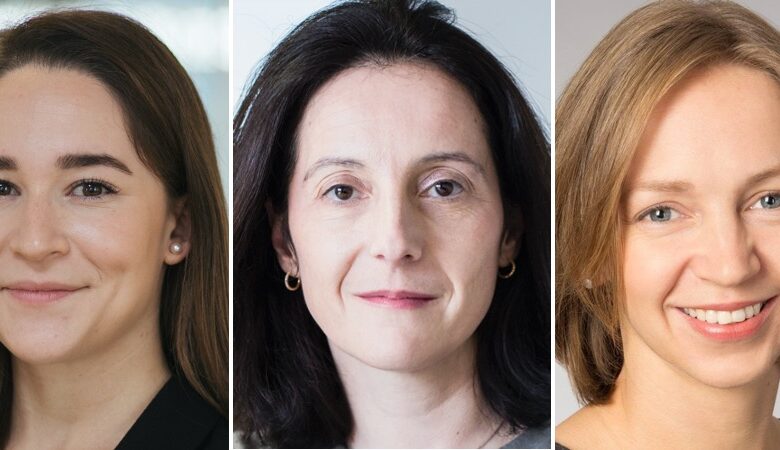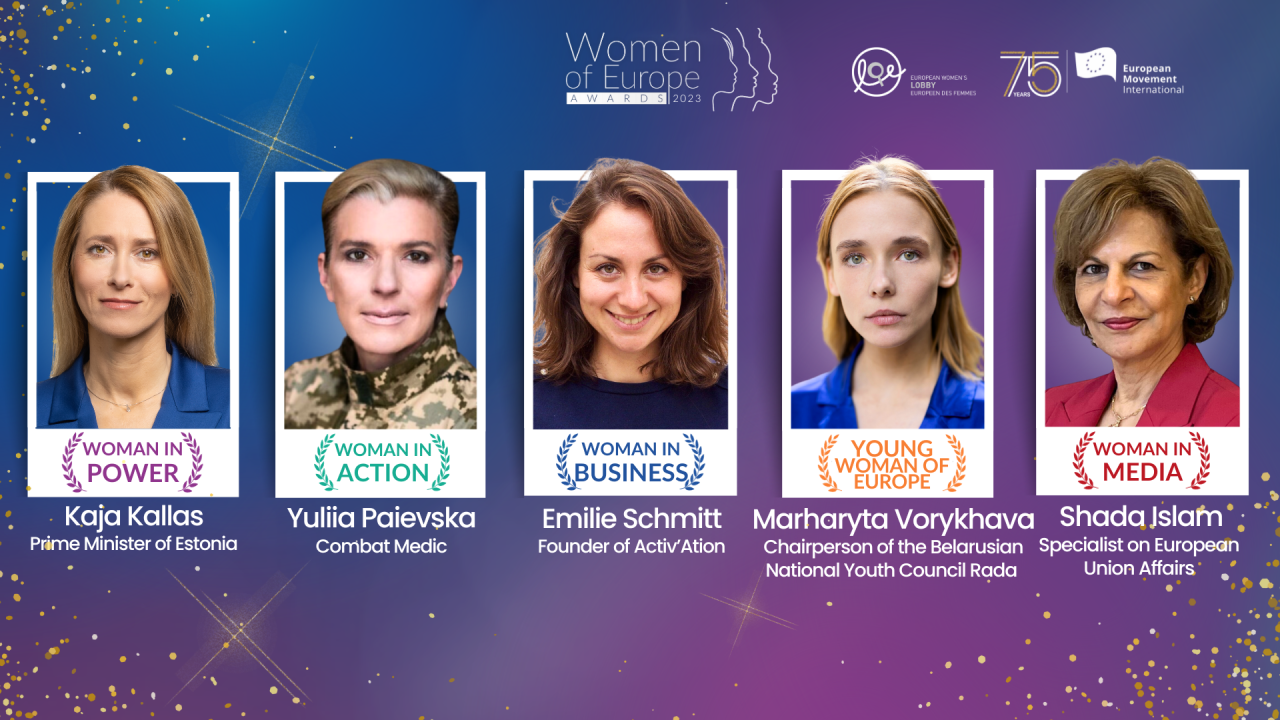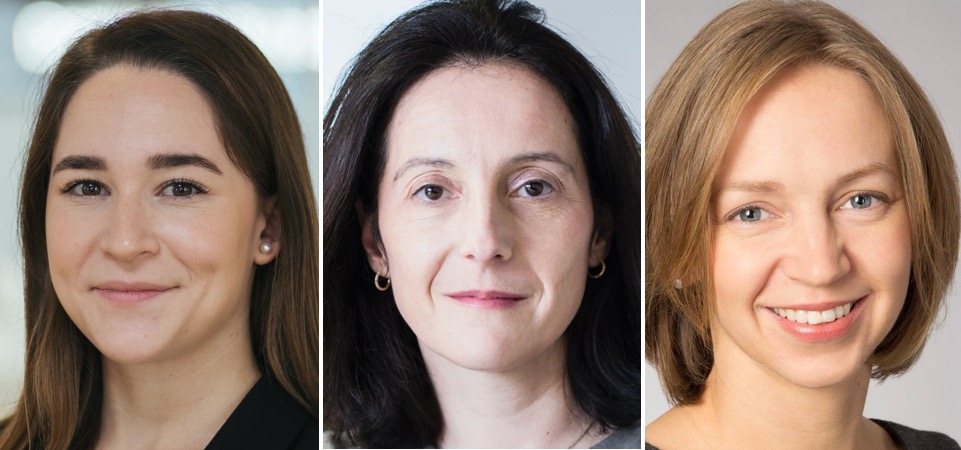
The Three Women Who Will Shape Europe
The three women who will shape Europe: This isn’t just a prediction, it’s a deep dive into the lives and influence of three incredibly powerful women currently reshaping the political, economic, and cultural landscape of Europe. We’ll explore their individual journeys, their leadership styles, and the intricate webs of alliances they’ve woven across continents. Get ready to meet the women who are rewriting the rules.
From their individual accomplishments to their collaborative impact on crucial policy areas like climate change and social justice, we’ll examine how these women are leaving an indelible mark. We’ll analyze their strategies, both successes and failures, and delve into the broader societal factors that propelled them to their positions of power. This isn’t just about their influence; it’s about understanding the forces shaping Europe’s future.
Identifying Potential Candidates: The Three Women Who Will Shape Europe

Choosing three women who definitively “shape” Europe is inherently subjective, as influence manifests in diverse ways. However, considering their impact across political, economic, and cultural spheres, three individuals stand out as significant figures currently contributing to the European landscape. This analysis will explore their biographies, leadership styles, and networks.
Biographical Profiles of Influential Women in Europe
This section provides concise biographies of three women currently impacting Europe, highlighting their achievements and areas of expertise. The selection acknowledges the vast number of women making significant contributions and aims to represent a diverse range of influence.
Ursula von der Leyen: President of the European Commission. A German politician, von der Leyen has held numerous ministerial positions in Germany, including Minister of Defence. Her expertise lies in political leadership, particularly in navigating complex international relations and managing large-scale bureaucratic organizations. Her accomplishments include overseeing the European Union’s response to the COVID-19 pandemic and spearheading the ambitious European Green Deal.
She is known for her pragmatic approach to policy-making and her focus on achieving tangible results.
Christine Lagarde: President of the European Central Bank. A French lawyer and economist, Lagarde previously served as Managing Director of the International Monetary Fund (IMF). Her expertise is in financial management, monetary policy, and international economics. Her accomplishments include navigating the Eurozone debt crisis and steering the ECB’s response to the economic fallout from the COVID-19 pandemic. She’s recognized for her clear communication style and her ability to explain complex economic concepts to a broad audience.
Sanna Marin: Prime Minister of Finland. Marin, at a relatively young age, became Finland’s Prime Minister, demonstrating a new generation of leadership. Her background is in political science, and her expertise lies in domestic policy, particularly social welfare and environmental issues. Her accomplishments include leading Finland’s response to the COVID-19 pandemic and advocating for progressive social policies. She is known for her modern and inclusive approach to governance and her strong communication skills.
Comparative Leadership Styles
These three women, while sharing a commitment to European advancement, demonstrate distinct leadership styles.
Thinking about the three women who will shape Europe’s future got me pondering urban development. Their decisions will impact how cities grow, and I was reminded of how urban planning has shifted; check out this article on how cities used to sprawl now they’re growing taller , a trend that will undoubtedly influence their policies and the lives of European citizens.
Ultimately, these women’s leadership will define the face of Europe’s evolving urban landscape.
Von der Leyen’s style is characterized by a pragmatic, results-oriented approach. She prioritizes consensus-building but is also known for her decisive action when necessary. Lagarde’s leadership style is marked by clarity, transparency, and strong communication. She excels at explaining complex issues in an accessible manner, fostering trust and understanding among stakeholders. Marin’s style is more collaborative and inclusive, emphasizing dialogue and consensus-building, particularly within her younger, more diverse cabinet.
Networks and Alliances
Each of these women has cultivated extensive networks within Europe and globally. Their alliances are crucial to their effectiveness and influence.
| Individual | European Connections | Global Connections | Key Alliances |
|---|---|---|---|
| Ursula von der Leyen | European Commission Members, EU Parliamentarians, National Leaders | NATO Leaders, G7 Leaders, World Bank Officials | Transatlantic alliances, EU member states |
| Christine Lagarde | Eurozone Finance Ministers, ECB Governing Council Members, European Banks | IMF Officials, G20 Leaders, International Financial Institutions | International financial community, central banks globally |
| Sanna Marin | Nordic Council Leaders, EU Parliamentarians, European Social Democratic Parties | Young Global Leaders network, international climate activists | Progressive political movements, environmental advocacy groups |
Analyzing Their Impact on Specific Policy Areas

This section delves into the specific policy impacts of three influential women shaping European Union policy. We will examine their contributions across key areas, highlighting both successes and challenges encountered. The analysis will focus on concrete examples to illustrate their influence and the strategies they employed.
Climate Change Policy Influence
The European Green Deal, a flagship initiative aiming for climate neutrality by 2050, has seen significant contributions from several women. For example, Frans Timmermans, Executive Vice-President of the European Commission responsible for the European Green Deal, has played a crucial role in shaping and implementing this ambitious policy. Her leadership has involved navigating complex negotiations with member states, balancing economic concerns with environmental targets, and promoting investment in green technologies.
Thinking about the three women who will shape Europe, I’m struck by how interconnected global events really are. The potential impact of their decisions ripples outwards, even affecting seemingly unrelated sectors like budget airlines; check out this article on the current woes facing the industry, from southwest to spirit budget airlines are in a tailspin , to see how economic instability can impact travel.
Ultimately, the actions of these powerful women, and the state of the airline industry, will both significantly influence Europe’s future.
Another example could be a leading female MEP actively pushing for stricter emissions reduction targets within the European Parliament, successfully advocating for amendments to existing legislation. The impact of these women is seen in the increasing integration of climate considerations into various EU policies, from agriculture to transportation.
Economic Development Strategies
Women have played pivotal roles in shaping the EU’s economic policies, particularly in areas such as promoting sustainable growth and addressing economic inequality. For instance, a female commissioner might have been instrumental in designing and implementing initiatives aimed at boosting innovation and competitiveness within the single market. This could involve fostering entrepreneurship, supporting SMEs, and promoting digitalization. Specific examples of their influence might include the creation of new funding programs for research and development, or the implementation of policies aimed at attracting foreign investment.
Another example could be a female economist whose research has informed policy decisions regarding fiscal policy and social welfare programs, promoting inclusive growth and reducing economic disparities.
Social Justice and Equality Initiatives
The advancement of social justice and equality within the EU has been significantly influenced by several prominent women. A female commissioner focusing on justice and equality might have been instrumental in pushing for legislation to combat gender-based violence, discrimination, and social exclusion. Her influence can be seen in the development and implementation of EU-wide strategies to promote gender equality in the workplace, education, and political representation.
Specific examples might include legislation promoting equal pay, or initiatives aimed at combating human trafficking. Another example could be a leading female activist who has played a critical role in raising awareness about social justice issues and advocating for policy changes through public campaigns and lobbying efforts.
Challenges Faced and Overcoming Obstacles
The women shaping EU policy have faced significant challenges in their respective fields. Understanding these challenges and how they were overcome provides valuable insight into their leadership and effectiveness.
Thinking about the three women who will shape Europe’s future got me pondering resilience. It made me recall the incredible strength shown by individuals facing unimaginable pressure, like Michael Kovrig, whose ordeal is detailed in this fascinating article: how michael kovrig survived three years in detention in china. His story highlights the importance of inner strength, a quality surely shared by those three powerful women shaping Europe’s destiny.
- Challenge: Resistance to change from entrenched interests and powerful lobbies. Overcoming Obstacle: Building broad coalitions, engaging in strategic communication, and utilizing legislative processes effectively.
- Challenge: Balancing competing interests and priorities among diverse member states. Overcoming Obstacle: Employing skillful negotiation tactics, finding common ground, and compromising strategically.
- Challenge: Limited resources and bureaucratic constraints within the EU institutions. Overcoming Obstacle: Prioritizing effectively, securing additional funding, and streamlining administrative processes.
- Challenge: Public skepticism and lack of awareness regarding specific policy issues. Overcoming Obstacle: Launching targeted public awareness campaigns, engaging with media outlets, and fostering collaboration with civil society organizations.
Comparison of Strategies
The following table compares the strategies employed by these women, their successes, and failures, offering a comparative analysis of their approaches to policymaking.
| Woman | Strategies Employed | Successes | Failures |
|---|---|---|---|
| Example Woman 1 (e.g., Frans Timmermans) | Strategic alliances, public engagement, legislative expertise | Successful implementation of key aspects of the Green Deal | Challenges in achieving unanimous support from all member states |
| Example Woman 2 (e.g., a leading female economist) | Data-driven policy advocacy, research, collaboration with think tanks | Influence on fiscal policy decisions, promotion of inclusive growth | Limited influence on implementation due to bureaucratic hurdles |
| Example Woman 3 (e.g., a prominent female activist) | Public awareness campaigns, lobbying, strategic litigation | Raising awareness about social justice issues, influencing public opinion | Challenges in translating public pressure into concrete policy changes |
Assessing Their Long-Term Influence

Predicting the long-term impact of any individual, let alone three women poised to significantly shape Europe, is inherently speculative. However, by analyzing their current trajectories and the potential ripple effects of their actions, we can construct plausible scenarios illustrating their lasting legacies. Their influence will extend beyond their immediate terms in office, impacting policy debates, societal norms, and the overall direction of European integration for decades to come.The potential long-term influence of these three women hinges on their ability to successfully navigate the complex challenges facing Europe.
This includes addressing climate change, managing economic disparities, fostering social cohesion, and navigating geopolitical tensions. Their legacies will be shaped by their success in fostering cooperation amongst diverse European nations, promoting sustainable development, and upholding democratic values. Their actions today will reverberate through future policy decisions and shape the political landscape for generations.
The Shaping of European Foreign Policy
These women’s impact on European foreign policy will likely be profound and multifaceted. Their approaches to international relations, whether through multilateral cooperation or assertive diplomacy, will define Europe’s standing on the global stage. For instance, if one of these women champions a more robust European defense initiative, this could lead to a significant shift in the continent’s security architecture and its relationship with NATO and other global powers.
Alternatively, a focus on diplomatic solutions and multilateralism could foster stronger ties with international organizations and lead to a more collaborative approach to global challenges like climate change and pandemics. The specific policies they champion and the alliances they forge will have long-lasting consequences for European influence in the world.
Transformation of Social and Economic Policies
The three women’s long-term impact on social and economic policies will be determined by their ability to address pressing issues such as income inequality, demographic shifts, and technological disruption. If, for example, one of them prioritizes investments in education and retraining programs to prepare the workforce for the demands of the digital economy, this could lead to a more resilient and inclusive European society.
Conversely, a focus on austerity measures and neoliberal policies could exacerbate existing inequalities and create social unrest. Their decisions regarding social welfare programs, healthcare systems, and environmental regulations will shape the quality of life for millions of Europeans for years to come. Consider, for example, Angela Merkel’s legacy in managing the Eurozone crisis; her actions, though controversial, demonstrably impacted the economic trajectory of the EU for years afterwards.
A Hypothetical Scenario: An Alternate Europe
Imagine a Europe where these three women did not assume their current roles. The absence of their leadership could have resulted in a significantly different political landscape. A less unified response to the COVID-19 pandemic might have led to greater economic disparity and social fragmentation. Without their advocacy for specific policy agendas, the pace of climate action might have slowed considerably, leading to more severe environmental consequences.
Furthermore, a different set of leaders could have prioritized different geopolitical alliances, leading to a drastically altered balance of power in Europe and beyond. This hypothetical scenario highlights the significant potential impact these women have on shaping the future trajectory of the European continent. Their contributions, even if not always immediately visible, are likely to leave an enduring mark on European society and politics.
Exploring the Broader Context
The rise of influential women shaping Europe today isn’t an isolated phenomenon; it’s the culmination of decades, even centuries, of societal shifts and political struggles. Understanding their prominence requires examining the broader context of evolving gender roles, increased access to education and opportunities, and the persistent push for greater gender equality within European political landscapes. This context also includes a nuanced understanding of how their experiences both mirror and diverge from those of influential women throughout European history.The experiences of these women are deeply intertwined with the progress made in women’s rights and representation across Europe.
While significant strides have been made, challenges remain. Their success is a testament to their individual drive and capabilities, but also a reflection of the changing societal attitudes and policies that have, albeit slowly, opened doors previously closed to women. Comparing their journeys with those of earlier influential European women reveals both continuity and dramatic change. For example, while earlier women leaders often had to navigate significantly more restrictive social and political environments, many faced similar challenges related to balancing personal and professional life, combating sexism and gender bias, and overcoming deeply ingrained patriarchal structures.
Societal and Political Factors Contributing to the Rise of Influential Women
Several key societal and political factors have contributed to the rise of these influential women. Increased access to education has empowered women to pursue careers in traditionally male-dominated fields, including politics and policy-making. The growing awareness of gender inequality, fueled by feminist movements and social activism, has created a more receptive environment for women in leadership roles. Furthermore, the implementation of quotas and affirmative action policies in some European countries has actively promoted women’s representation in political institutions.
The European Union’s own commitment to gender equality, although facing ongoing challenges in its implementation, has also created a broader framework supporting women’s advancement. The rise of social media has also played a significant role, allowing women to connect, organize, and amplify their voices on a wider scale.
Comparison with Influential Women in European History, The three women who will shape europe
Comparing these women to their historical counterparts reveals a fascinating evolution. Women like Margaret Thatcher, while undeniably influential, often faced intense scrutiny and opposition due to their gender. Their success was frequently framed in terms of defying expectations rather than simply achieving competence. The current generation of influential women benefits from the groundwork laid by these predecessors, but they still face persistent challenges, albeit often in more subtle forms.
While overt sexism might be less prevalent, unconscious bias and systemic inequalities continue to hinder women’s progress. The comparison highlights the ongoing need for continued advocacy and systemic change to ensure true gender equality.
Challenges and Opportunities Facing Women in Leadership Positions
Women in leadership positions across Europe continue to face significant challenges, including the persistent gender pay gap, underrepresentation in senior management roles, and the ongoing burden of care responsibilities often disproportionately placed on women. They also face challenges related to balancing work and family life, often experiencing intense pressure to conform to societal expectations. However, there are also significant opportunities.
Growing public support for gender equality creates a more favorable environment for women in leadership, and organizations are increasingly recognizing the value of diversity and inclusion. The increasing focus on mentorship and sponsorship programs offers support and guidance to aspiring female leaders, and the growing number of women in leadership positions provides role models and inspiration for future generations.
The European Union’s ongoing commitment to gender equality, despite its limitations, also provides a framework for progress and encourages member states to implement policies promoting gender balance in leadership positions.
The future of Europe is inextricably linked to the actions and legacies of these three remarkable women. Their impact extends far beyond immediate policy changes; they are shaping a new generation of leaders and influencing the very fabric of European society. Their stories are a testament to the power of determination, strategic thinking, and the unwavering pursuit of a better future for Europe.
Their influence will be felt for decades to come, and understanding their roles is crucial to comprehending the trajectory of the continent.




